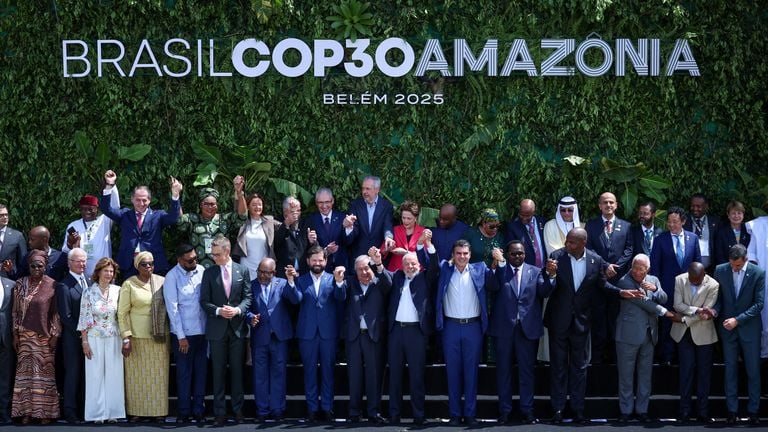Looking back on COP29
The UN climate talks in Baku were labelled as the “finance COP”, and while negotiators did agree a breakthrough new funding goal, the summit had unfinished business on fossil fuels and was surrounded in controversy.
Main financial outcomes
Countries agreed a new collective quantified goal on climate finance (NCQG), committing developed nations to “mobilise at least $300 billion a year into developing countries by 2035” , tripling the last pledge.
An ambitious framework was agreed, the “Baku-to-Belém Roadmap to $1.3T”. Its aim is to “mobilise $1.3 trillion a year by 2035 from all sources” . Yet, developing countries were “bitterly disappointed” that the target fell short of their call for $1.3 trillion a year in public finance alone as this new deal relied heavily on private capital.
Breakthroughs and Deferrals
Ten years after the Paris Agreement was signed, COP29 achieved what was called the “Baku breakthrough” by finalising the remaining Article 6 rules on carbon markets, providing long-awaited clarity on authorising and tracking mitigation outcomes between countries. Yet countries failed to agree how to implement last year’s pledge to “transition away from fossil fuels”, instead deferring the issue to COP30 in Belém, Brazil.
Wider Political Context
COP29 was under scrutiny due to Azerbaijan’s presidency, as a petrostate host whose economy depends on oil and gas. Trump winning the US election also cast a shadow over COP29, with his talks about backing out of the Paris agreement, again. Within some of the mitigation negotiations the South African environmental minister said the USA was more subdued at COP29 when normally “they talk a lot”. Dr Leon Sealey-Huggins, a senior campaigner at War on Want, expressed his frustrations: “People [were] saying: Well, you better take this money, because when Trump comes, you’re not going to get any money.” Demonstrating the failure of the global north to appreciate that you can’t have a global climate response without global climate justice. His comment reflected the ubiquitous sense that COP29’s finance deal was driven by fear of future U.S. disengagement rather than genuine solidarity.
COP30
As COP30 begins, scientists warn that global temperatures are increasing 50% faster than before, with the world likely to exceed 1.5°C of warming by 2030.
COP29 delivered a finance framework but not a fossil-fuel phase-out plan. The $300 billion target gives COP30 something tangible to build on, though some cautioned that it is “less ambitious than it seems”, given its reliance on private capital and distant 2035 timeline. The conference will also test whether the Baku–Belém Roadmap can scale climate finance from $300 billion to $1.3 trillion by 2035 and deliver what vulnerable nations see as genuine climate justice.

Efforts to end deforestation
Brazil’s presidency of COP30 set the perfect background within the Amazon to ending forest loss, boosting climate finance, and “turning negotiations into action” as core objectives. Its Tropical Forests Forever Facility aims to raise $125 billion to reward countries for protecting forests, beginning with a $10 billion first-year goal. This creates an incentive for local people to preserve forests for their livelihood rather than fell them. But they have not led by example by felling tens of thousands of acres of protected Amazon rainforest to build a four-lane highway for COP30.
Roughly 1.6 billion people rely on forests for their livelihoods, they are one of the most biodiverse places on land, home to over 80% of terrestrial species. Not only does deforestation remove this habitat but it also prevents further sequestration and emits CO2 due to the upturning of the soil.
A solution could be afforestation; younger trees absorb more CO2 than older trees, but older trees can store more within the soil. There are some forests where more carbon is stored in the soil than in the trunks.
But afforestation could be a relatively short-term solution with research suggesting the increase in heat and concentration of CO2 are increasing the speed of tree growth which is shortening their lifetimes. Therefore, in roughly 100 years’ time we might need to double our afforestation efforts.
Countries’ Nationally Determined Contributions (NDCs)
COP30 is being framed as both a “nature COP” but also a defining moment for the third round of Nationally Determined Contributions (NDCs 3.0) covering 2031–35.
Brazil
Brazil’s NDCs have set out to reduce net greenhouse gas (GHG) emissions by 59- 67% by 2035, compared to 2005 levels. Presenting stronger 2035 NDCs than some other countries. Yet they are exploring new oil drilling in and near the Amazon basin.
Europe
The EU has submitted an updated NDC targeting a 66- 72.5% cut in emissions by 2035, presenting this as proof that “Europe is staying the course”, despite the USA dropping out. The UK, committing to an 81% reduction by 2035, and is promoting its green-growth agenda while facing criticism for limited forest-fund support.
China and India
China’s NDCs 3.0 are a 7- 10% absolute CO₂ reduction from peak levels and 30% non-fossil energy share, but many analysts expect China to over-deliver on given the pace of its clean-energy adoption. Renewables, batteries and EVs together are contributing to a quarter of China’s economic growth.
India is preparing an updated NDC 3.0, sticking to its 2070 net-zero date and arguing for “fair, country-specific” metrics that reflect development needs.
United States
The United States’ absence from Belém has been branded a “watershed moment” by EU climate chief Wopke Hoekstra, who warned that when the world’s second-largest current emitter and biggest historical emitter “basically says, ‘Well, you sort it out,’ [that] clearly that does damage”. They are also once again pulling out of the Paris agreement, set to be finalised in January.
We will monitor and report on COP30 developments in the next two weeks as it is set to be a defining moment for global climate action, aiming to deliver concrete progress on ending deforestation, securing fair climate finance, updating 2035 emission targets, and agreeing on a pathway to phase out fossil fuels.





